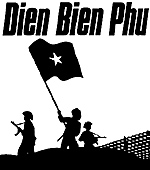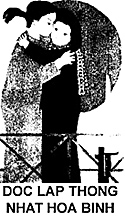
Introduction
Dien Bien Phu
Designed by Guy R. Hail
Published 1973 by Conflict Games
Historical research by David A Parham
Playtesting by Local San Diego war gamers under the direction of Jack Greene
Dien Bien Phu covers the six year culmination of the French involvement in Indo-China (1950-1955). This is the first and only version of the game published. It was originally included as a magazine game (along with John Hill’s Battle for Hue) in issue 6 of Conflict magazine. The game includes one unmounted, three-color (blue, black, red and white) 16” by 10 1/2 ” map, two plotting sheets and 89 mounted, one-sided die-cut 1/2 ” counters. The counter sheet includes the counters for Battle for Hue units as well, thus the oddball number. The rules are on an accordion-folded 7”x10:” sheet.
The map is an area (22 areas in all) representation of the important regions of northern Indochina, Laos and southern China. The areas vary widely in the square mileage covered, with the urban and heavily populated areas being much smaller and the less developed and populated areas being much larger. All of China is divided into only two areas, Kwangsi and Yunnan. There is little differentiation of terrain. Only the three de Lattre Line fortified areas (Hai Phong, Thai Binh and Hanoi) and the five coastal/riverine provinces (Yen Bay, Hoa Binh, Thanh Hoa, Vinh, Hon Gay and Lang Son) are functionally different from any other area. Each area (except for the two Chinese provinces) also contains a boxed internal area representing a major city or airfield, usable only by the French.
There is no terrain per se: no mountains, jungles or rivers; just areas.
Units represent Divisions, Half Divisions (dare I say Demi-Divisions?), Regimental Combat Teams, Demi-Brigades and Battle Groups, depending on national organization. Aside from unit designation there is no other information on the units. As a matter of a fact, except for mobility, combat units are differentiated only as to regular and irregular combat units. Mobility classes are Dinassault (DNA ... Naval Assault Division), GAP (Airborne Battle Group) and everybody else. The DNA units can freely move between any two coastal or riverine provinces each turn, but can move nowhere else on the map. The GAP units can be paradropped to any province on the map from any province on the map, except for China (big surprise), one unit each turn (there are two GAP units).
The French may also airlift any one regular unit each turn from a controlled city to another controlled city (except for the DNA). The Vietminh units move two areas per turn, the French units one area per turn, irregulars do not move once placed. All movement is pre-plotted each turn on the plotting sheets, although lined paper will suffice. Combat occurs when units attempt to enter an enemy held area, or units cross into each other in movement. Combat results at any odds except for 1-1 are automatic with Elimination and Retreat results. 1-1 Combats are resolved on a 4x4 matrix with Eliminations, Retreats and Combination results. The combat system is very similar to SDC’s Dunkurque 1940. Major cities or airfields represent an area within an area and must be attacked, if garrisoned, after the area is taken or retreated into.
Irregular units cannot retreat and are automatically eliminated if faced with overwhelming odds, but cannot be attacked otherwise. The Vietminh is constrained by supply limitations. He starts with five supply and gets two per turn thereafter. Vietminh units require supply to move into French occupied areas or attack French units (one supply for two combat units). There are reinforcements and replacements, although not many, and, as mentioned above, the Vietminh get a steady stream of Supply units.
 Game play is fast and the full game can be easily finished in one sitting. My memories of this when I first received it (via subscription!) and played it were quite fond, but I recently replayed it to refresh my memory and the game seemed fairly flat. Units are too difficult to kill, and both sides can move units around pretty freely. Even with 22 areas to cover it is very difficult to concentrate the large force needed to get a kill, without leaving other units vulnerable to a similar action from the enemy. The territorial-based victory conditions are very hard, as it is
impossible to hold onto some of the areas and also get the rest without telegraphing your moves or leaving vulnerable garrisons. Thus, the game is usually decided at the end of turn 14 and is won by the player holding more areas. It is possible to attain the other victory conditions (territorial or single turn kills); I just don’t see two competent players doing it often.
Game play is fast and the full game can be easily finished in one sitting. My memories of this when I first received it (via subscription!) and played it were quite fond, but I recently replayed it to refresh my memory and the game seemed fairly flat. Units are too difficult to kill, and both sides can move units around pretty freely. Even with 22 areas to cover it is very difficult to concentrate the large force needed to get a kill, without leaving other units vulnerable to a similar action from the enemy. The territorial-based victory conditions are very hard, as it is
impossible to hold onto some of the areas and also get the rest without telegraphing your moves or leaving vulnerable garrisons. Thus, the game is usually decided at the end of turn 14 and is won by the player holding more areas. It is possible to attain the other victory conditions (territorial or single turn kills); I just don’t see two competent players doing it often.
The game devolves into doing a waltz with territory taken, regained, retaken, and all the while the enemy is doing exactly the same thing. The system is fairly unique, combining a plotted Diplomacy-type movement system with a somewhat unusual combat system. The designer has a few other war games to his credit but is primarily an RPG designer. It is one of only two English language campaign games on the French Indo-China war (3rd Millennia’s First Indochina War being the other) made, to my knowledge. I cannot remember seeing this or any other Conflict games on eBay, r.g.b.m., or anywhere else for that matter. For all these reasons, I would rate it a Collector’s Item.
Counter Manifest
Vietminh (White type on Red background)
- 7 Irregular Forces
11 Supply Units
16 Control Markers
6 Movement Arrows
12 Infantry Divisions (A&B each of 320, 325, 312, 304, 316, 308)
2 Artillery Division (A & B)
2 Independent Irregulars (1 & 2)
French (White type on Blue background)
- 3 Irregular Forces
2 Control Markers 1 0 Movement Arrows
2 Airborne Battle Groups (1 & 2)
2 Colonial Irregulars(1 & 2)
7 Regimental Combat Teams (1, 2, 3, 4, 7, 14, Viet)
1 Foreign Legion Demi-Brigade
4 Dinassault Divisions (1, 2, 3, 4)
1 Turn Marker
[Note: The count on the Control Markers and Movement Arrows may be inaccurate. The two copies I have of the game have different numbers of each, but, as they are generic and not limited, it is of little consequence to the player.]
Other Games by Guy R. Hail
Ardennes 1944 (American Designers Association, 1972); Armored Assault (ADA, 1972); Dien Bien Phu (Flying Buffalo, 1977); First Indochina War (3rd Millenia Inc., 1973); Indochina (ADA, 1972); PanzerDivision (ADA, 1972); Salerno 1943 (ADA, 1972); Savo Island (ADA, 1972); Tannenburg (ADA, 1972); Western Front Tank Leader (West End, 1987).
He also released a slew of RPG designs, mainly Mythos, Call of Cthullu and Glorantha.
Introduction
Dien Bien Phu by Luc Olivier
Dien Bien Phu by Allan Rothberg
Back to Simulacrum Vol. 2 No. 4 Table of Contents
Back to Simulacrum List of Issues
Back to MagWeb Master Magazine List
© Copyright 2000 by Steambubble Graphics
This article appears in MagWeb (Magazine Web) on the Internet World Wide Web. Other military history articles and gaming articles are available at http://www.magweb.com